Service Marketing: Service Delivery Failure Scenario and Recovery Strategies
VerifiedAdded on 2023/06/04
|10
|2498
|189
AI Summary
This paper discusses a service delivery failure scenario in the hospitality sector, identifies the type of complaint and its root cause, proposes a service recovery program and strategies, and provides recommendations to maintain customer loyalty and retention.
Contribute Materials
Your contribution can guide someone’s learning journey. Share your
documents today.
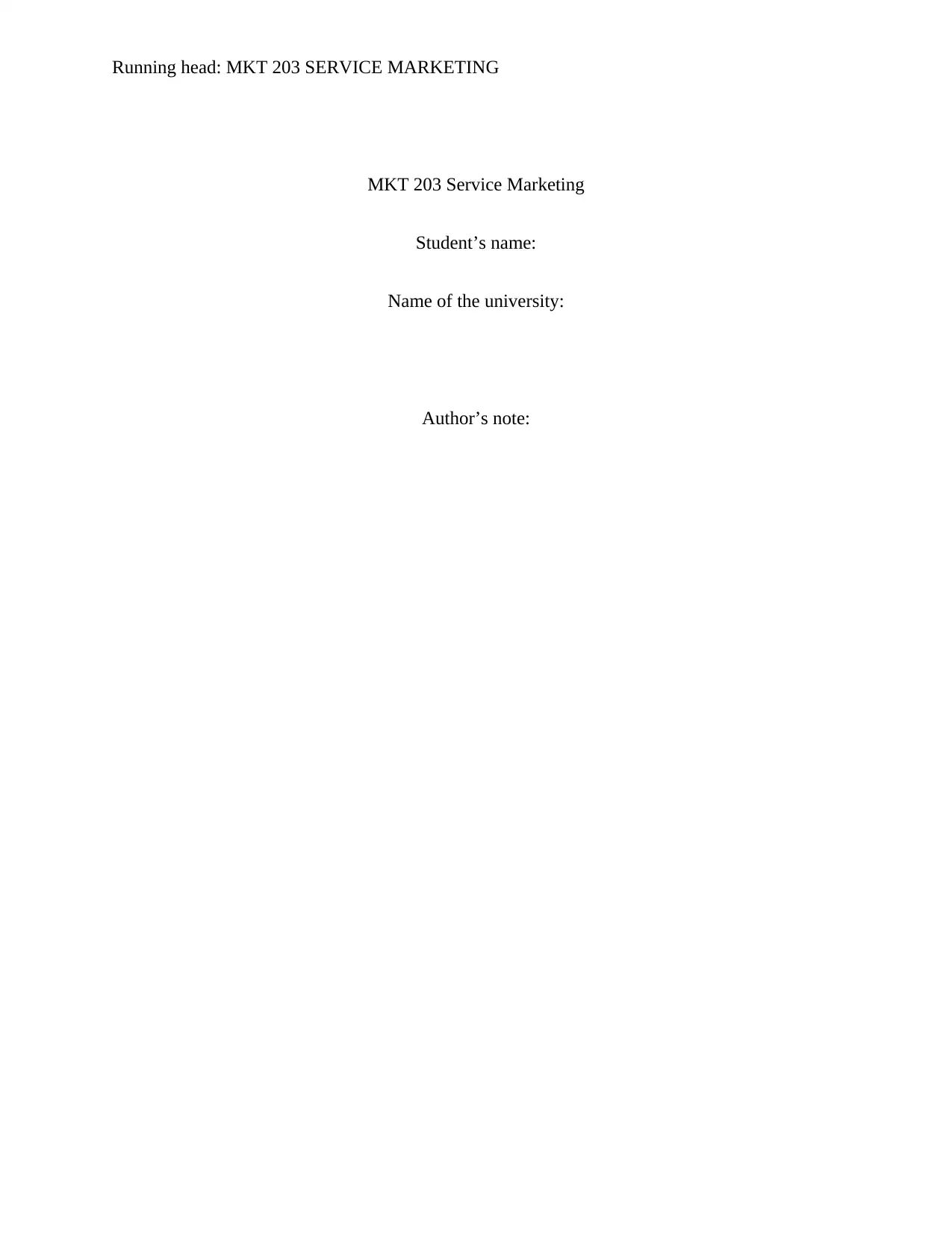
Running head: MKT 203 SERVICE MARKETING
MKT 203 Service Marketing
Student’s name:
Name of the university:
Author’s note:
MKT 203 Service Marketing
Student’s name:
Name of the university:
Author’s note:
Secure Best Marks with AI Grader
Need help grading? Try our AI Grader for instant feedback on your assignments.
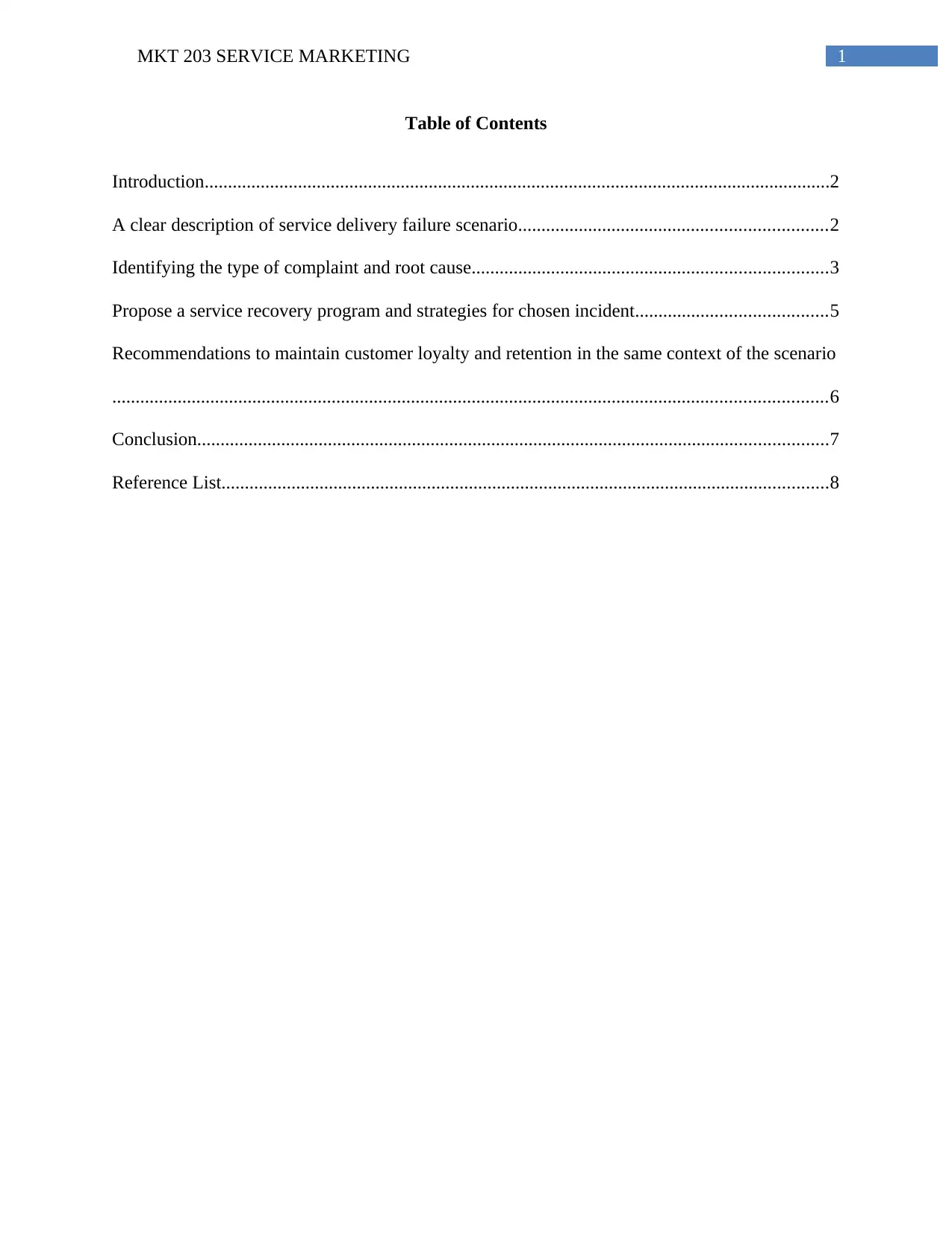
1MKT 203 SERVICE MARKETING
Table of Contents
Introduction......................................................................................................................................2
A clear description of service delivery failure scenario..................................................................2
Identifying the type of complaint and root cause............................................................................3
Propose a service recovery program and strategies for chosen incident.........................................5
Recommendations to maintain customer loyalty and retention in the same context of the scenario
.........................................................................................................................................................6
Conclusion.......................................................................................................................................7
Reference List..................................................................................................................................8
Table of Contents
Introduction......................................................................................................................................2
A clear description of service delivery failure scenario..................................................................2
Identifying the type of complaint and root cause............................................................................3
Propose a service recovery program and strategies for chosen incident.........................................5
Recommendations to maintain customer loyalty and retention in the same context of the scenario
.........................................................................................................................................................6
Conclusion.......................................................................................................................................7
Reference List..................................................................................................................................8
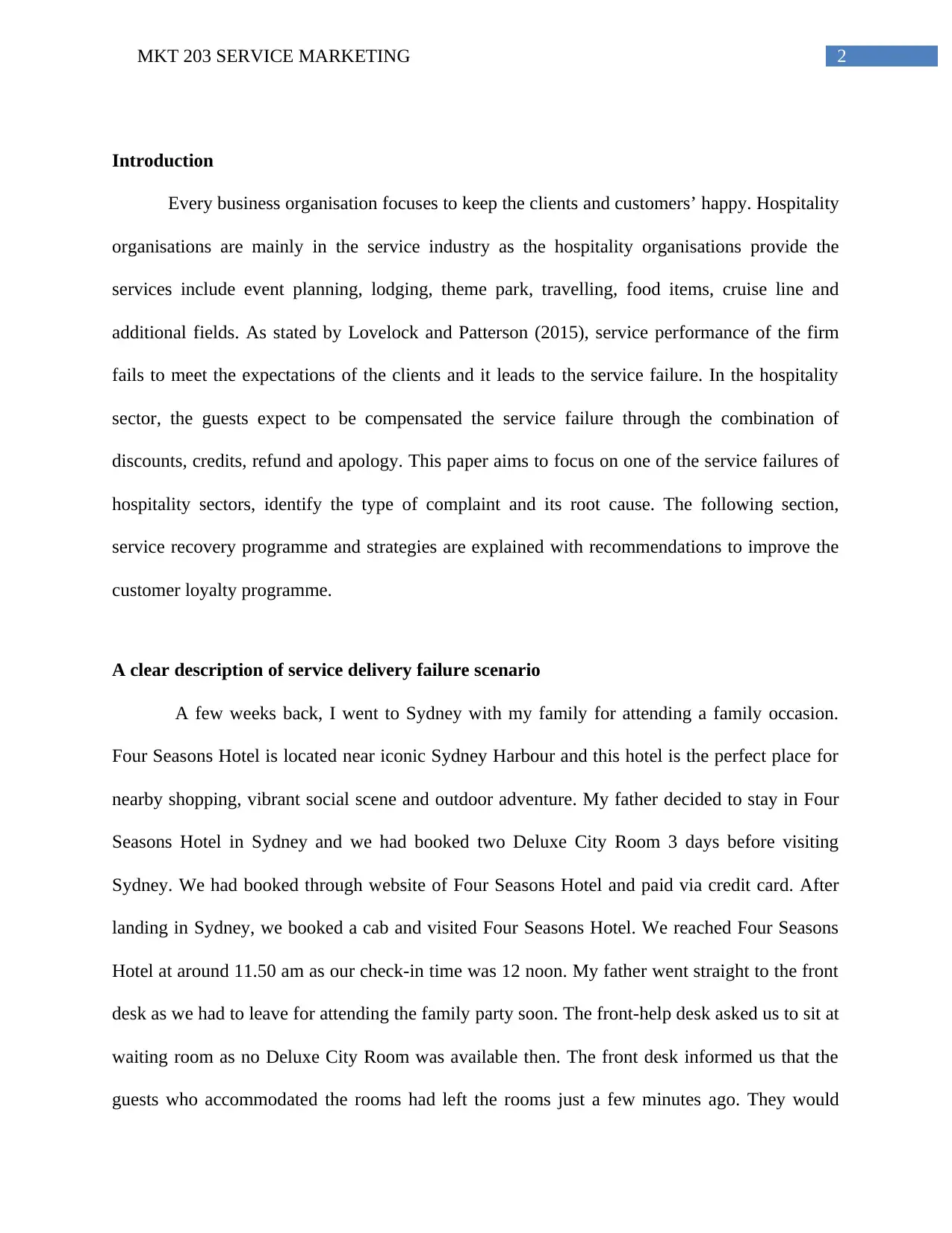
2MKT 203 SERVICE MARKETING
Introduction
Every business organisation focuses to keep the clients and customers’ happy. Hospitality
organisations are mainly in the service industry as the hospitality organisations provide the
services include event planning, lodging, theme park, travelling, food items, cruise line and
additional fields. As stated by Lovelock and Patterson (2015), service performance of the firm
fails to meet the expectations of the clients and it leads to the service failure. In the hospitality
sector, the guests expect to be compensated the service failure through the combination of
discounts, credits, refund and apology. This paper aims to focus on one of the service failures of
hospitality sectors, identify the type of complaint and its root cause. The following section,
service recovery programme and strategies are explained with recommendations to improve the
customer loyalty programme.
A clear description of service delivery failure scenario
A few weeks back, I went to Sydney with my family for attending a family occasion.
Four Seasons Hotel is located near iconic Sydney Harbour and this hotel is the perfect place for
nearby shopping, vibrant social scene and outdoor adventure. My father decided to stay in Four
Seasons Hotel in Sydney and we had booked two Deluxe City Room 3 days before visiting
Sydney. We had booked through website of Four Seasons Hotel and paid via credit card. After
landing in Sydney, we booked a cab and visited Four Seasons Hotel. We reached Four Seasons
Hotel at around 11.50 am as our check-in time was 12 noon. My father went straight to the front
desk as we had to leave for attending the family party soon. The front-help desk asked us to sit at
waiting room as no Deluxe City Room was available then. The front desk informed us that the
guests who accommodated the rooms had left the rooms just a few minutes ago. They would
Introduction
Every business organisation focuses to keep the clients and customers’ happy. Hospitality
organisations are mainly in the service industry as the hospitality organisations provide the
services include event planning, lodging, theme park, travelling, food items, cruise line and
additional fields. As stated by Lovelock and Patterson (2015), service performance of the firm
fails to meet the expectations of the clients and it leads to the service failure. In the hospitality
sector, the guests expect to be compensated the service failure through the combination of
discounts, credits, refund and apology. This paper aims to focus on one of the service failures of
hospitality sectors, identify the type of complaint and its root cause. The following section,
service recovery programme and strategies are explained with recommendations to improve the
customer loyalty programme.
A clear description of service delivery failure scenario
A few weeks back, I went to Sydney with my family for attending a family occasion.
Four Seasons Hotel is located near iconic Sydney Harbour and this hotel is the perfect place for
nearby shopping, vibrant social scene and outdoor adventure. My father decided to stay in Four
Seasons Hotel in Sydney and we had booked two Deluxe City Room 3 days before visiting
Sydney. We had booked through website of Four Seasons Hotel and paid via credit card. After
landing in Sydney, we booked a cab and visited Four Seasons Hotel. We reached Four Seasons
Hotel at around 11.50 am as our check-in time was 12 noon. My father went straight to the front
desk as we had to leave for attending the family party soon. The front-help desk asked us to sit at
waiting room as no Deluxe City Room was available then. The front desk informed us that the
guests who accommodated the rooms had left the rooms just a few minutes ago. They would
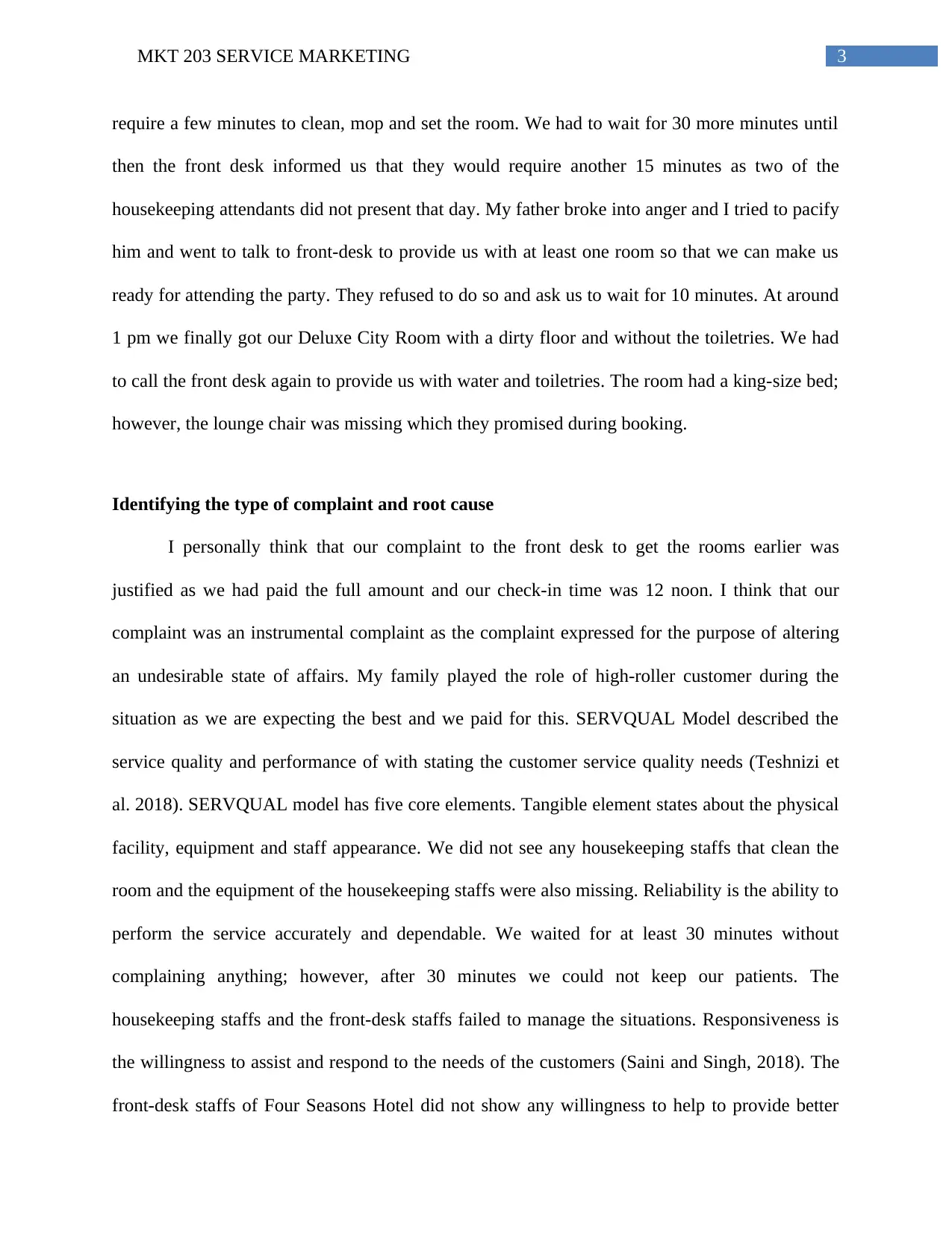
3MKT 203 SERVICE MARKETING
require a few minutes to clean, mop and set the room. We had to wait for 30 more minutes until
then the front desk informed us that they would require another 15 minutes as two of the
housekeeping attendants did not present that day. My father broke into anger and I tried to pacify
him and went to talk to front-desk to provide us with at least one room so that we can make us
ready for attending the party. They refused to do so and ask us to wait for 10 minutes. At around
1 pm we finally got our Deluxe City Room with a dirty floor and without the toiletries. We had
to call the front desk again to provide us with water and toiletries. The room had a king-size bed;
however, the lounge chair was missing which they promised during booking.
Identifying the type of complaint and root cause
I personally think that our complaint to the front desk to get the rooms earlier was
justified as we had paid the full amount and our check-in time was 12 noon. I think that our
complaint was an instrumental complaint as the complaint expressed for the purpose of altering
an undesirable state of affairs. My family played the role of high-roller customer during the
situation as we are expecting the best and we paid for this. SERVQUAL Model described the
service quality and performance of with stating the customer service quality needs (Teshnizi et
al. 2018). SERVQUAL model has five core elements. Tangible element states about the physical
facility, equipment and staff appearance. We did not see any housekeeping staffs that clean the
room and the equipment of the housekeeping staffs were also missing. Reliability is the ability to
perform the service accurately and dependable. We waited for at least 30 minutes without
complaining anything; however, after 30 minutes we could not keep our patients. The
housekeeping staffs and the front-desk staffs failed to manage the situations. Responsiveness is
the willingness to assist and respond to the needs of the customers (Saini and Singh, 2018). The
front-desk staffs of Four Seasons Hotel did not show any willingness to help to provide better
require a few minutes to clean, mop and set the room. We had to wait for 30 more minutes until
then the front desk informed us that they would require another 15 minutes as two of the
housekeeping attendants did not present that day. My father broke into anger and I tried to pacify
him and went to talk to front-desk to provide us with at least one room so that we can make us
ready for attending the party. They refused to do so and ask us to wait for 10 minutes. At around
1 pm we finally got our Deluxe City Room with a dirty floor and without the toiletries. We had
to call the front desk again to provide us with water and toiletries. The room had a king-size bed;
however, the lounge chair was missing which they promised during booking.
Identifying the type of complaint and root cause
I personally think that our complaint to the front desk to get the rooms earlier was
justified as we had paid the full amount and our check-in time was 12 noon. I think that our
complaint was an instrumental complaint as the complaint expressed for the purpose of altering
an undesirable state of affairs. My family played the role of high-roller customer during the
situation as we are expecting the best and we paid for this. SERVQUAL Model described the
service quality and performance of with stating the customer service quality needs (Teshnizi et
al. 2018). SERVQUAL model has five core elements. Tangible element states about the physical
facility, equipment and staff appearance. We did not see any housekeeping staffs that clean the
room and the equipment of the housekeeping staffs were also missing. Reliability is the ability to
perform the service accurately and dependable. We waited for at least 30 minutes without
complaining anything; however, after 30 minutes we could not keep our patients. The
housekeeping staffs and the front-desk staffs failed to manage the situations. Responsiveness is
the willingness to assist and respond to the needs of the customers (Saini and Singh, 2018). The
front-desk staffs of Four Seasons Hotel did not show any willingness to help to provide better
Secure Best Marks with AI Grader
Need help grading? Try our AI Grader for instant feedback on your assignments.
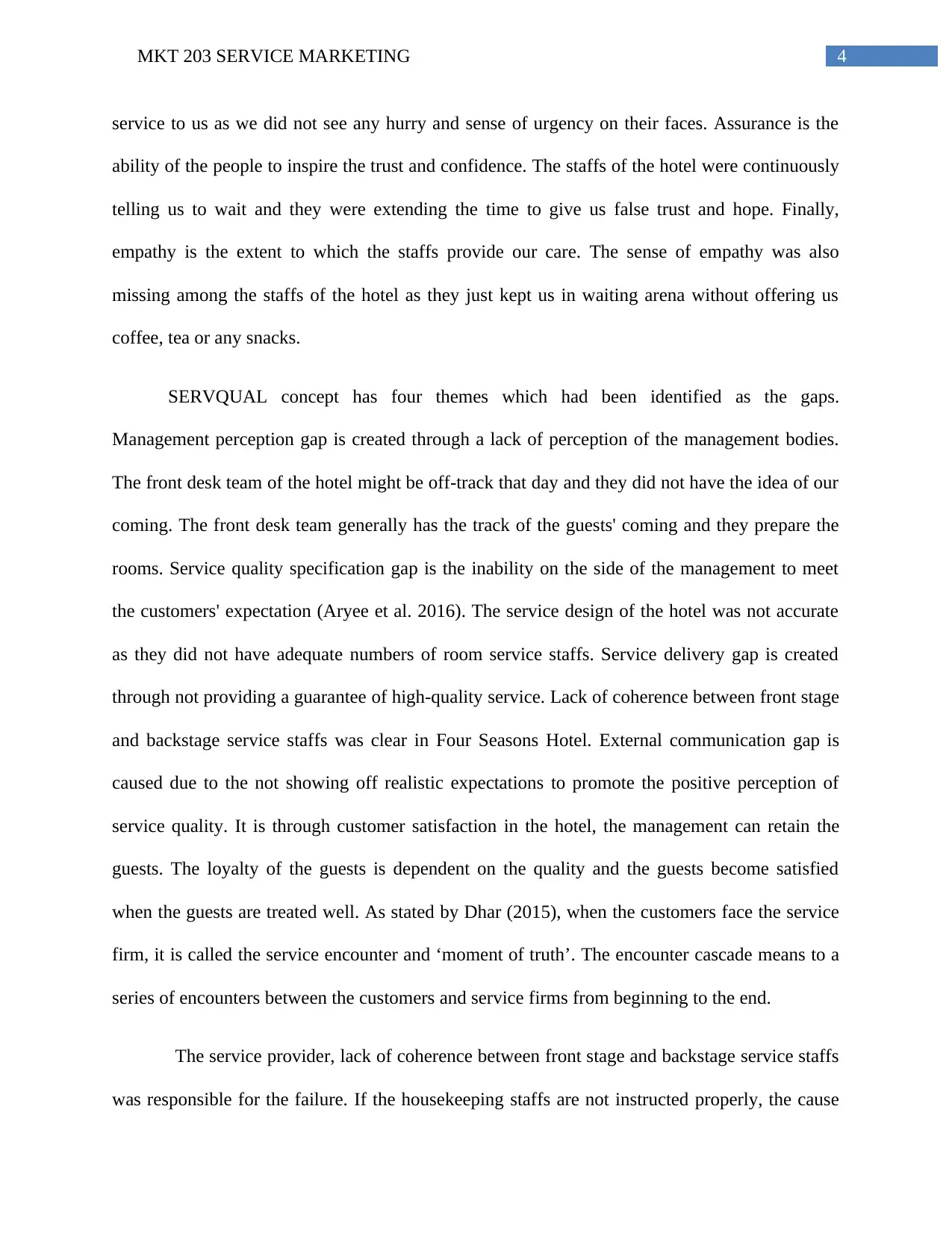
4MKT 203 SERVICE MARKETING
service to us as we did not see any hurry and sense of urgency on their faces. Assurance is the
ability of the people to inspire the trust and confidence. The staffs of the hotel were continuously
telling us to wait and they were extending the time to give us false trust and hope. Finally,
empathy is the extent to which the staffs provide our care. The sense of empathy was also
missing among the staffs of the hotel as they just kept us in waiting arena without offering us
coffee, tea or any snacks.
SERVQUAL concept has four themes which had been identified as the gaps.
Management perception gap is created through a lack of perception of the management bodies.
The front desk team of the hotel might be off-track that day and they did not have the idea of our
coming. The front desk team generally has the track of the guests' coming and they prepare the
rooms. Service quality specification gap is the inability on the side of the management to meet
the customers' expectation (Aryee et al. 2016). The service design of the hotel was not accurate
as they did not have adequate numbers of room service staffs. Service delivery gap is created
through not providing a guarantee of high-quality service. Lack of coherence between front stage
and backstage service staffs was clear in Four Seasons Hotel. External communication gap is
caused due to the not showing off realistic expectations to promote the positive perception of
service quality. It is through customer satisfaction in the hotel, the management can retain the
guests. The loyalty of the guests is dependent on the quality and the guests become satisfied
when the guests are treated well. As stated by Dhar (2015), when the customers face the service
firm, it is called the service encounter and ‘moment of truth’. The encounter cascade means to a
series of encounters between the customers and service firms from beginning to the end.
The service provider, lack of coherence between front stage and backstage service staffs
was responsible for the failure. If the housekeeping staffs are not instructed properly, the cause
service to us as we did not see any hurry and sense of urgency on their faces. Assurance is the
ability of the people to inspire the trust and confidence. The staffs of the hotel were continuously
telling us to wait and they were extending the time to give us false trust and hope. Finally,
empathy is the extent to which the staffs provide our care. The sense of empathy was also
missing among the staffs of the hotel as they just kept us in waiting arena without offering us
coffee, tea or any snacks.
SERVQUAL concept has four themes which had been identified as the gaps.
Management perception gap is created through a lack of perception of the management bodies.
The front desk team of the hotel might be off-track that day and they did not have the idea of our
coming. The front desk team generally has the track of the guests' coming and they prepare the
rooms. Service quality specification gap is the inability on the side of the management to meet
the customers' expectation (Aryee et al. 2016). The service design of the hotel was not accurate
as they did not have adequate numbers of room service staffs. Service delivery gap is created
through not providing a guarantee of high-quality service. Lack of coherence between front stage
and backstage service staffs was clear in Four Seasons Hotel. External communication gap is
caused due to the not showing off realistic expectations to promote the positive perception of
service quality. It is through customer satisfaction in the hotel, the management can retain the
guests. The loyalty of the guests is dependent on the quality and the guests become satisfied
when the guests are treated well. As stated by Dhar (2015), when the customers face the service
firm, it is called the service encounter and ‘moment of truth’. The encounter cascade means to a
series of encounters between the customers and service firms from beginning to the end.
The service provider, lack of coherence between front stage and backstage service staffs
was responsible for the failure. If the housekeeping staffs are not instructed properly, the cause
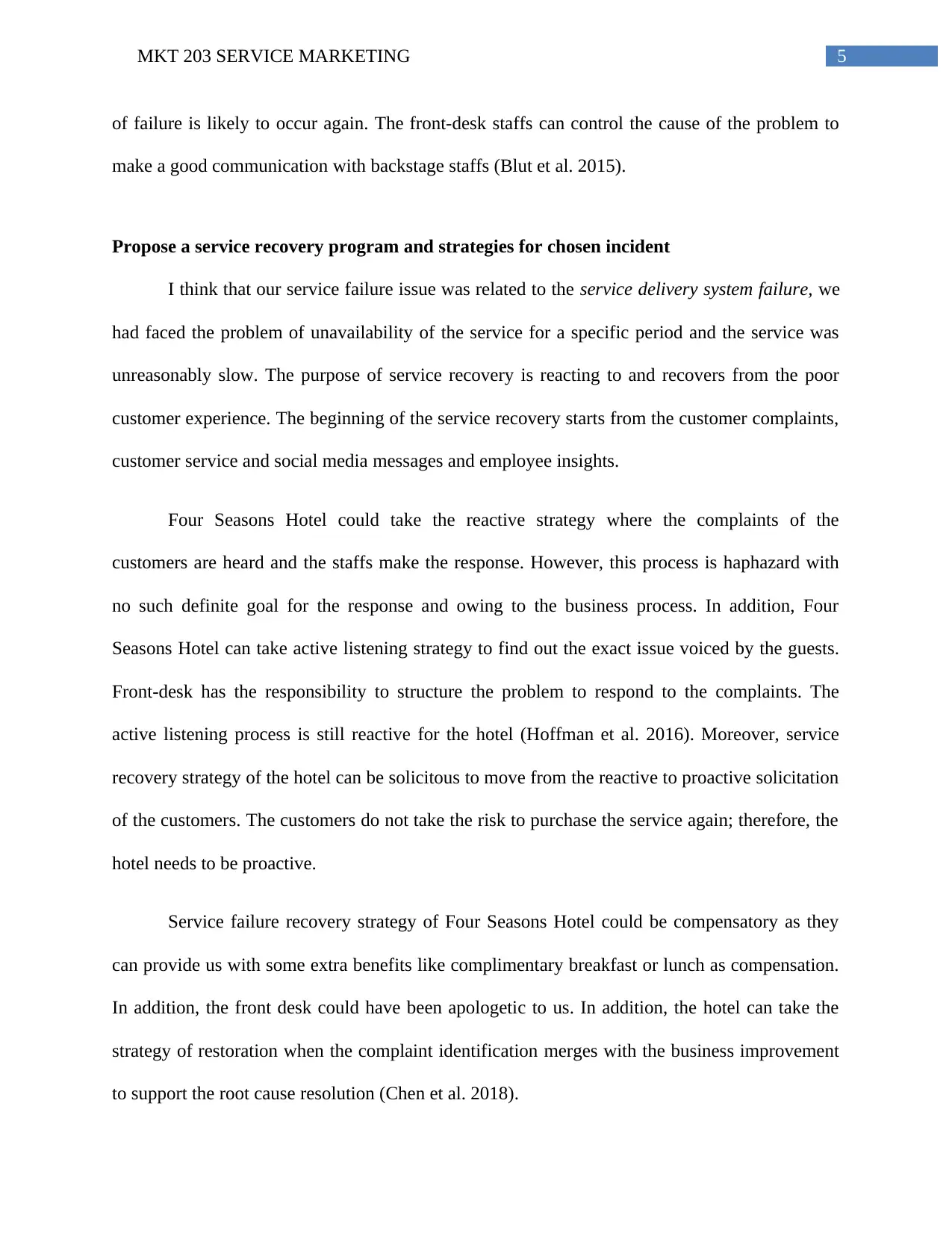
5MKT 203 SERVICE MARKETING
of failure is likely to occur again. The front-desk staffs can control the cause of the problem to
make a good communication with backstage staffs (Blut et al. 2015).
Propose a service recovery program and strategies for chosen incident
I think that our service failure issue was related to the service delivery system failure, we
had faced the problem of unavailability of the service for a specific period and the service was
unreasonably slow. The purpose of service recovery is reacting to and recovers from the poor
customer experience. The beginning of the service recovery starts from the customer complaints,
customer service and social media messages and employee insights.
Four Seasons Hotel could take the reactive strategy where the complaints of the
customers are heard and the staffs make the response. However, this process is haphazard with
no such definite goal for the response and owing to the business process. In addition, Four
Seasons Hotel can take active listening strategy to find out the exact issue voiced by the guests.
Front-desk has the responsibility to structure the problem to respond to the complaints. The
active listening process is still reactive for the hotel (Hoffman et al. 2016). Moreover, service
recovery strategy of the hotel can be solicitous to move from the reactive to proactive solicitation
of the customers. The customers do not take the risk to purchase the service again; therefore, the
hotel needs to be proactive.
Service failure recovery strategy of Four Seasons Hotel could be compensatory as they
can provide us with some extra benefits like complimentary breakfast or lunch as compensation.
In addition, the front desk could have been apologetic to us. In addition, the hotel can take the
strategy of restoration when the complaint identification merges with the business improvement
to support the root cause resolution (Chen et al. 2018).
of failure is likely to occur again. The front-desk staffs can control the cause of the problem to
make a good communication with backstage staffs (Blut et al. 2015).
Propose a service recovery program and strategies for chosen incident
I think that our service failure issue was related to the service delivery system failure, we
had faced the problem of unavailability of the service for a specific period and the service was
unreasonably slow. The purpose of service recovery is reacting to and recovers from the poor
customer experience. The beginning of the service recovery starts from the customer complaints,
customer service and social media messages and employee insights.
Four Seasons Hotel could take the reactive strategy where the complaints of the
customers are heard and the staffs make the response. However, this process is haphazard with
no such definite goal for the response and owing to the business process. In addition, Four
Seasons Hotel can take active listening strategy to find out the exact issue voiced by the guests.
Front-desk has the responsibility to structure the problem to respond to the complaints. The
active listening process is still reactive for the hotel (Hoffman et al. 2016). Moreover, service
recovery strategy of the hotel can be solicitous to move from the reactive to proactive solicitation
of the customers. The customers do not take the risk to purchase the service again; therefore, the
hotel needs to be proactive.
Service failure recovery strategy of Four Seasons Hotel could be compensatory as they
can provide us with some extra benefits like complimentary breakfast or lunch as compensation.
In addition, the front desk could have been apologetic to us. In addition, the hotel can take the
strategy of restoration when the complaint identification merges with the business improvement
to support the root cause resolution (Chen et al. 2018).
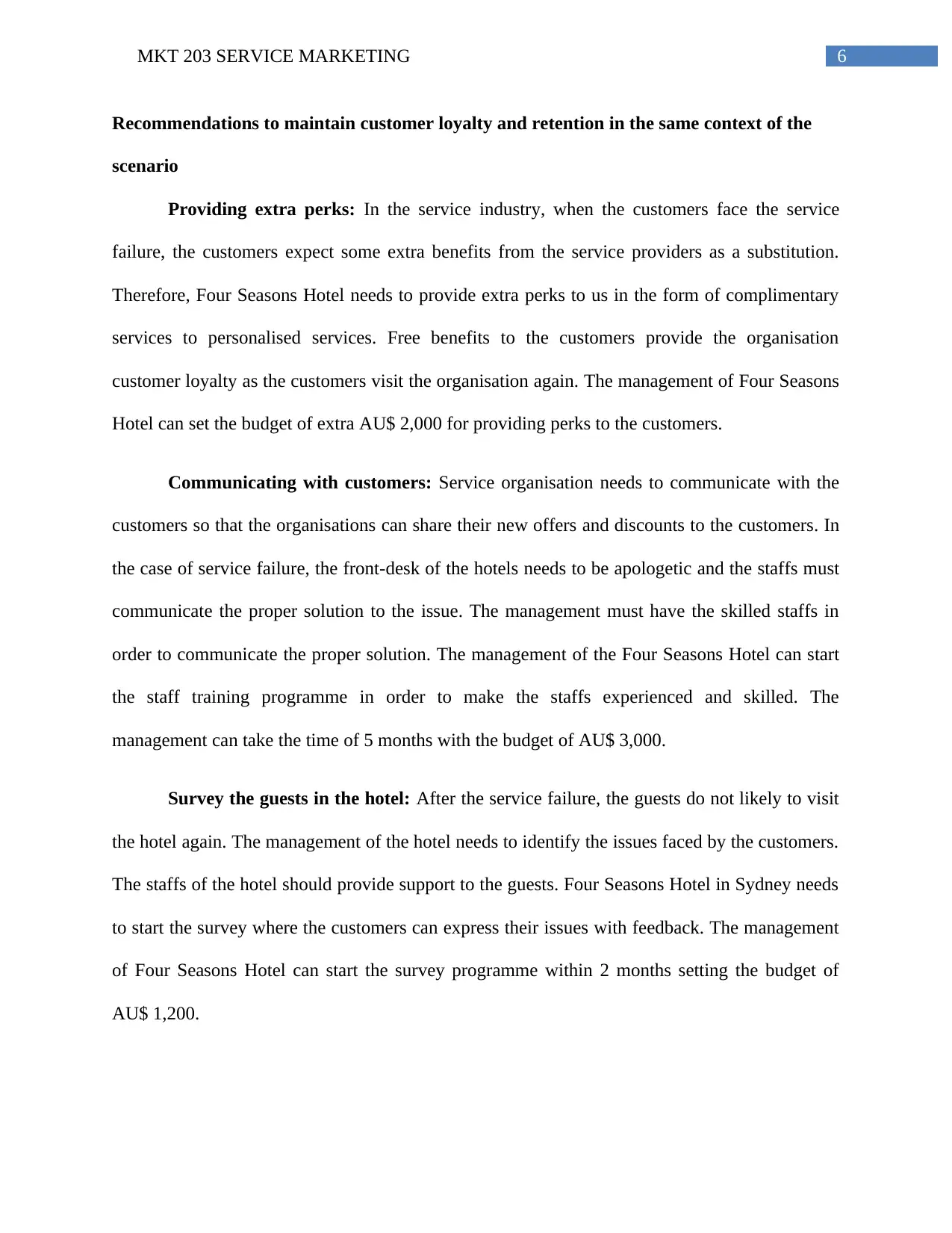
6MKT 203 SERVICE MARKETING
Recommendations to maintain customer loyalty and retention in the same context of the
scenario
Providing extra perks: In the service industry, when the customers face the service
failure, the customers expect some extra benefits from the service providers as a substitution.
Therefore, Four Seasons Hotel needs to provide extra perks to us in the form of complimentary
services to personalised services. Free benefits to the customers provide the organisation
customer loyalty as the customers visit the organisation again. The management of Four Seasons
Hotel can set the budget of extra AU$ 2,000 for providing perks to the customers.
Communicating with customers: Service organisation needs to communicate with the
customers so that the organisations can share their new offers and discounts to the customers. In
the case of service failure, the front-desk of the hotels needs to be apologetic and the staffs must
communicate the proper solution to the issue. The management must have the skilled staffs in
order to communicate the proper solution. The management of the Four Seasons Hotel can start
the staff training programme in order to make the staffs experienced and skilled. The
management can take the time of 5 months with the budget of AU$ 3,000.
Survey the guests in the hotel: After the service failure, the guests do not likely to visit
the hotel again. The management of the hotel needs to identify the issues faced by the customers.
The staffs of the hotel should provide support to the guests. Four Seasons Hotel in Sydney needs
to start the survey where the customers can express their issues with feedback. The management
of Four Seasons Hotel can start the survey programme within 2 months setting the budget of
AU$ 1,200.
Recommendations to maintain customer loyalty and retention in the same context of the
scenario
Providing extra perks: In the service industry, when the customers face the service
failure, the customers expect some extra benefits from the service providers as a substitution.
Therefore, Four Seasons Hotel needs to provide extra perks to us in the form of complimentary
services to personalised services. Free benefits to the customers provide the organisation
customer loyalty as the customers visit the organisation again. The management of Four Seasons
Hotel can set the budget of extra AU$ 2,000 for providing perks to the customers.
Communicating with customers: Service organisation needs to communicate with the
customers so that the organisations can share their new offers and discounts to the customers. In
the case of service failure, the front-desk of the hotels needs to be apologetic and the staffs must
communicate the proper solution to the issue. The management must have the skilled staffs in
order to communicate the proper solution. The management of the Four Seasons Hotel can start
the staff training programme in order to make the staffs experienced and skilled. The
management can take the time of 5 months with the budget of AU$ 3,000.
Survey the guests in the hotel: After the service failure, the guests do not likely to visit
the hotel again. The management of the hotel needs to identify the issues faced by the customers.
The staffs of the hotel should provide support to the guests. Four Seasons Hotel in Sydney needs
to start the survey where the customers can express their issues with feedback. The management
of Four Seasons Hotel can start the survey programme within 2 months setting the budget of
AU$ 1,200.
Paraphrase This Document
Need a fresh take? Get an instant paraphrase of this document with our AI Paraphraser
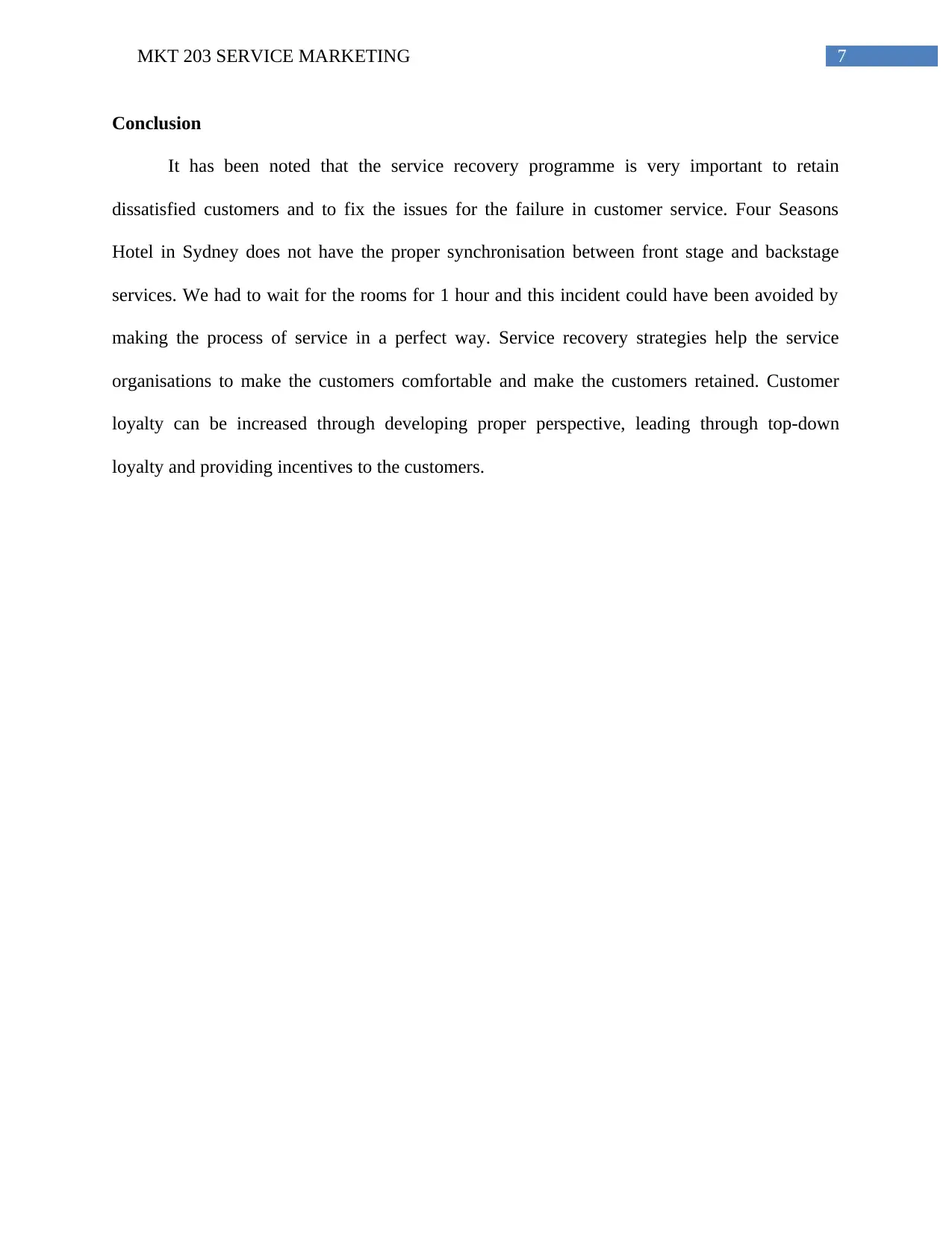
7MKT 203 SERVICE MARKETING
Conclusion
It has been noted that the service recovery programme is very important to retain
dissatisfied customers and to fix the issues for the failure in customer service. Four Seasons
Hotel in Sydney does not have the proper synchronisation between front stage and backstage
services. We had to wait for the rooms for 1 hour and this incident could have been avoided by
making the process of service in a perfect way. Service recovery strategies help the service
organisations to make the customers comfortable and make the customers retained. Customer
loyalty can be increased through developing proper perspective, leading through top-down
loyalty and providing incentives to the customers.
Conclusion
It has been noted that the service recovery programme is very important to retain
dissatisfied customers and to fix the issues for the failure in customer service. Four Seasons
Hotel in Sydney does not have the proper synchronisation between front stage and backstage
services. We had to wait for the rooms for 1 hour and this incident could have been avoided by
making the process of service in a perfect way. Service recovery strategies help the service
organisations to make the customers comfortable and make the customers retained. Customer
loyalty can be increased through developing proper perspective, leading through top-down
loyalty and providing incentives to the customers.
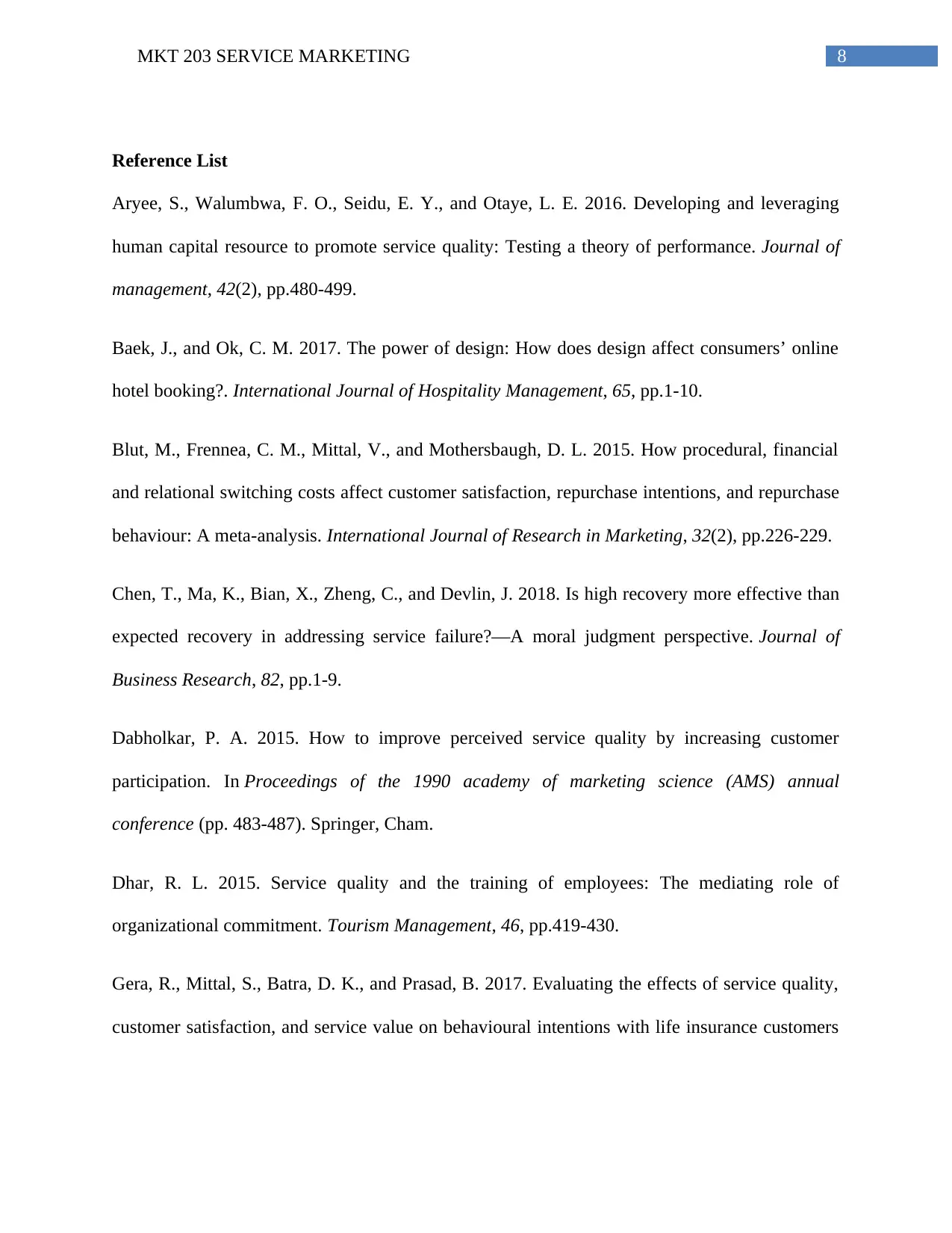
8MKT 203 SERVICE MARKETING
Reference List
Aryee, S., Walumbwa, F. O., Seidu, E. Y., and Otaye, L. E. 2016. Developing and leveraging
human capital resource to promote service quality: Testing a theory of performance. Journal of
management, 42(2), pp.480-499.
Baek, J., and Ok, C. M. 2017. The power of design: How does design affect consumers’ online
hotel booking?. International Journal of Hospitality Management, 65, pp.1-10.
Blut, M., Frennea, C. M., Mittal, V., and Mothersbaugh, D. L. 2015. How procedural, financial
and relational switching costs affect customer satisfaction, repurchase intentions, and repurchase
behaviour: A meta-analysis. International Journal of Research in Marketing, 32(2), pp.226-229.
Chen, T., Ma, K., Bian, X., Zheng, C., and Devlin, J. 2018. Is high recovery more effective than
expected recovery in addressing service failure?—A moral judgment perspective. Journal of
Business Research, 82, pp.1-9.
Dabholkar, P. A. 2015. How to improve perceived service quality by increasing customer
participation. In Proceedings of the 1990 academy of marketing science (AMS) annual
conference (pp. 483-487). Springer, Cham.
Dhar, R. L. 2015. Service quality and the training of employees: The mediating role of
organizational commitment. Tourism Management, 46, pp.419-430.
Gera, R., Mittal, S., Batra, D. K., and Prasad, B. 2017. Evaluating the effects of service quality,
customer satisfaction, and service value on behavioural intentions with life insurance customers
Reference List
Aryee, S., Walumbwa, F. O., Seidu, E. Y., and Otaye, L. E. 2016. Developing and leveraging
human capital resource to promote service quality: Testing a theory of performance. Journal of
management, 42(2), pp.480-499.
Baek, J., and Ok, C. M. 2017. The power of design: How does design affect consumers’ online
hotel booking?. International Journal of Hospitality Management, 65, pp.1-10.
Blut, M., Frennea, C. M., Mittal, V., and Mothersbaugh, D. L. 2015. How procedural, financial
and relational switching costs affect customer satisfaction, repurchase intentions, and repurchase
behaviour: A meta-analysis. International Journal of Research in Marketing, 32(2), pp.226-229.
Chen, T., Ma, K., Bian, X., Zheng, C., and Devlin, J. 2018. Is high recovery more effective than
expected recovery in addressing service failure?—A moral judgment perspective. Journal of
Business Research, 82, pp.1-9.
Dabholkar, P. A. 2015. How to improve perceived service quality by increasing customer
participation. In Proceedings of the 1990 academy of marketing science (AMS) annual
conference (pp. 483-487). Springer, Cham.
Dhar, R. L. 2015. Service quality and the training of employees: The mediating role of
organizational commitment. Tourism Management, 46, pp.419-430.
Gera, R., Mittal, S., Batra, D. K., and Prasad, B. 2017. Evaluating the effects of service quality,
customer satisfaction, and service value on behavioural intentions with life insurance customers
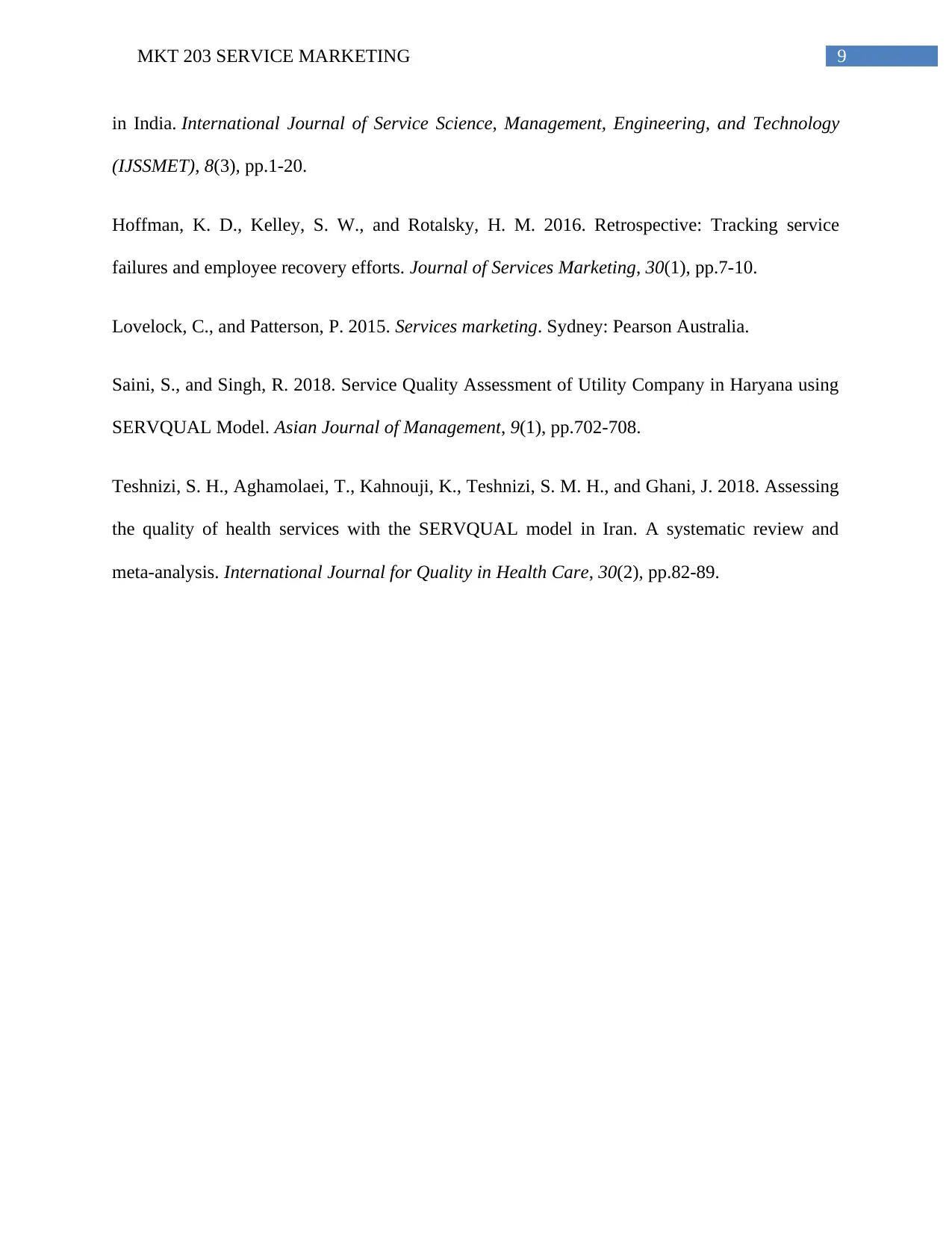
9MKT 203 SERVICE MARKETING
in India. International Journal of Service Science, Management, Engineering, and Technology
(IJSSMET), 8(3), pp.1-20.
Hoffman, K. D., Kelley, S. W., and Rotalsky, H. M. 2016. Retrospective: Tracking service
failures and employee recovery efforts. Journal of Services Marketing, 30(1), pp.7-10.
Lovelock, C., and Patterson, P. 2015. Services marketing. Sydney: Pearson Australia.
Saini, S., and Singh, R. 2018. Service Quality Assessment of Utility Company in Haryana using
SERVQUAL Model. Asian Journal of Management, 9(1), pp.702-708.
Teshnizi, S. H., Aghamolaei, T., Kahnouji, K., Teshnizi, S. M. H., and Ghani, J. 2018. Assessing
the quality of health services with the SERVQUAL model in Iran. A systematic review and
meta-analysis. International Journal for Quality in Health Care, 30(2), pp.82-89.
in India. International Journal of Service Science, Management, Engineering, and Technology
(IJSSMET), 8(3), pp.1-20.
Hoffman, K. D., Kelley, S. W., and Rotalsky, H. M. 2016. Retrospective: Tracking service
failures and employee recovery efforts. Journal of Services Marketing, 30(1), pp.7-10.
Lovelock, C., and Patterson, P. 2015. Services marketing. Sydney: Pearson Australia.
Saini, S., and Singh, R. 2018. Service Quality Assessment of Utility Company in Haryana using
SERVQUAL Model. Asian Journal of Management, 9(1), pp.702-708.
Teshnizi, S. H., Aghamolaei, T., Kahnouji, K., Teshnizi, S. M. H., and Ghani, J. 2018. Assessing
the quality of health services with the SERVQUAL model in Iran. A systematic review and
meta-analysis. International Journal for Quality in Health Care, 30(2), pp.82-89.
1 out of 10
Your All-in-One AI-Powered Toolkit for Academic Success.
+13062052269
info@desklib.com
Available 24*7 on WhatsApp / Email
![[object Object]](/_next/static/media/star-bottom.7253800d.svg)
Unlock your academic potential
© 2024 | Zucol Services PVT LTD | All rights reserved.

